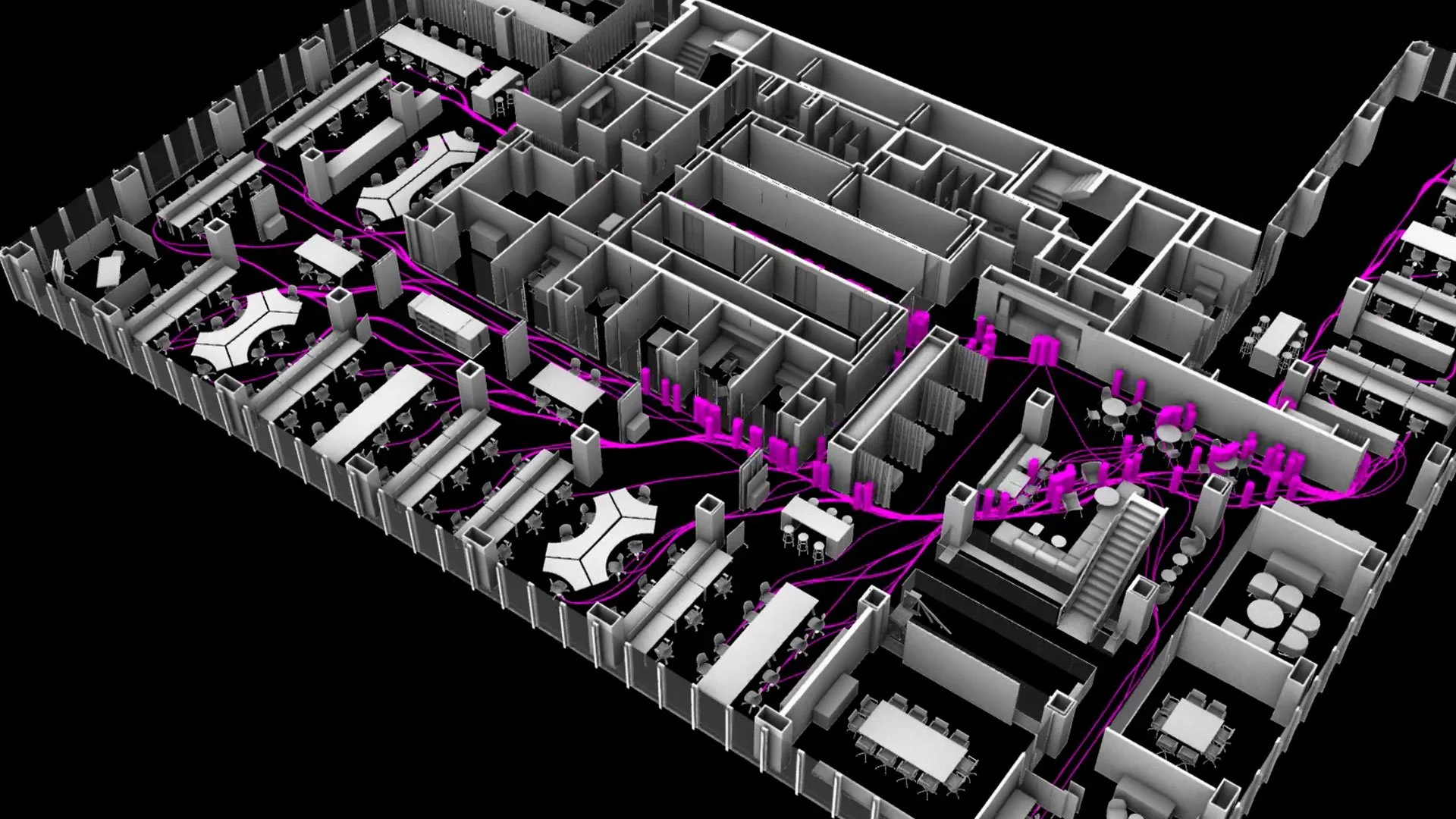Social Graph Analytics and the Power of Spatial Intelligence: Landlord of the future Part 2
In today's world, landlords who utilize AI and new technology to enhance the tenant experience gain a significant competitive advantage. By analyzing behavioral data , including movement patterns, collaboration hotspots, and trends in space usage, landlords are equipped to design environments tailored to how people actually interact, and connect.
These so-called “social graphs” can also enhance our understanding of the invisible dynamics among people within a building or development, facilitating the selection of suitable tenants and their strategic placement to encourage collaboration and shared value.
In this second installment of our “Landlord of the Future” series, we explore how social graph analytics empowers landlords to evolve into data-driven ecosystem orchestrators, maximizing community value, operational and leasing performance, and tenant satisfaction.
What Are Social Graphs and Why They Matter in Real Estate
Social graph analytics use anonymized movement and interaction data—think badge swipes, occupancy sensors, collaboration tool usage, and Wi-Fi signals—to map how people interact across space and time. Taking this interdisciplinary approach, which spans anthropology, behavioral science, and game theory, and enhancing it with AI forges an entirely new approach to real estate.
Research on how social graph analytics can help landlords design more optimized spaces is under way. For real estate decision-makers, this level of insight represents a major shift. By leveraging social graph analytics to understand how space is truly used, property owners can dramatically reduce inefficiencies in space programming — allocating square footage where it actually supports collaboration and productivity. The result is smarter investments, optimized layouts, and a more compelling offer for tenants seeking flexible, high-performing environments.
The Strategic Value of Curated Tenant Mixes
The potential of social graph analytics transcends interior design—it also influences tenant strategy to carefully consider not just WHAT tenants they seek, but WHERE they're placed and HOW they share spaces. By leveraging readily-available data, landlords and property owners can make evidence-based decisions that drive value, improve tenant satisfaction, and create more resilient, high-performing spaces.
In many ways, this is not a new concept. At the city scale, the foundational aspects of economic development and urban planning rest upon the idea that communities, neighborhoods and clusters grow, attract and retain businesses and tenants based on a synergy effect of having readily available labor, policies, and infrastructure in place. The presence of zoning laws, skilled professionals for required services, amenities, housing and attractions has led to the development of the Research Triangle in North Carolina, a hub for technology and biotech, and “Rocket City” in Huntsville, Alabama, a hub for aerospace, to name just a few examples. Taken together, industries can grow and places can transform.
These concepts can also be applied to the building scale where data about how people move, what they are interested in and how they interact can create a flywheel effect of individual well-being and collective economic impact. So, what does “social graph analytics” look like in the context of curating a tenant mix? Some key applications include:
Behavioral Compatibility Matching: AI can analyze tenant behavior patterns, work styles, and collaboration preferences to optimize floor plans and adjacencies. For example, a landlord could pair quiet-focused teams away from high-traffic collaborative spaces, or place companies with complementary business models near each other to foster organic partnerships (like locating a graphic design studio near a marketing agency or web developer, as they often collaborate).
Dynamic Space Utilization Optimization: Machine learning algorithms can predict space usage patterns based on tenant type, seasonality, and business cycles. This allows landlords to strategically place tenants who have complementary peak usage times in flexible or shared spaces, maximizing overall building efficiency.
Community Chemistry Algorithms: AI can analyze tenant data (industry, company culture, employee demographics, growth stage) to create "chemistry scores" that predict which tenants will create positive ecosystem effects. Think of it as matchmaking for building communities - placing a design agency next to a startup accelerator, or ensuring the right mix of established companies and emerging businesses.
Predictive Conflict Prevention: By analyzing noise patterns, foot traffic, delivery schedules, and operational behaviors, AI can identify potential friction points before they occur. This prevents issues like placing a 24/7 operation next to a traditional 9-5 office, or putting high-delivery-volume tenants in areas that would congest shared spaces.
Shared Space Choreography: AI can orchestrate how tenants interact with shared amenities - from conference rooms to rooftop spaces - by learning usage patterns and preferences to minimize conflicts and maximize satisfaction. This includes optimizing booking systems and even suggesting optimal times for different tenant types.

Case study spotlight
Michigan Central
UrbanSense has been helping architect an innovation ecosystem at Michigan Central focused on mobility, tech and culture. Through the support of UrbanSense, Michigan Central is creating an innovation ecosystem anchored in Detroit’s historic train station by cultivating industry partnerships and startups, creating purpose built spaces to support collaboration and platforms to build, test and deploy new mobility and logistics solutions, and establishing skills and workforce development programs that respond to industry needs.
Technology Tools Empowering Strategic Tenant Curation
Ensuring that tenants and their employees are aligned can be quite challenging. To address this, landlords are utilizing technologies that facilitate data-driven decisions, enhancing tenant experiences and optimizing building performance. Some technological tools that can be employed to improve tenant engagement include:
Advanced Analytics Platforms: Today’s advanced analytics platforms use machine learning to surface insights we simply couldn’t access before—like identifying underutilized zones or predicting peak usage patterns. These tools can turn raw occupancy data into strategic planning assets. These platforms provide occupancy analytics including occupancy rate per square foot, high-traffic zones, and occupancy heat maps and can support “Organizational Network Analysis” (ONA) - a method using social graph analytics to examine internal communication flows, allowing landlords to optimize office layouts for enhanced productivity by understanding interaction patterns.
Current Market Examples: Basking AI, CountMatters, VergeSense
Predictive Collaboration Modeling: This is where the future is headed. It's no longer just about how much space people need—it’s about how they engage with it. AI-driven solutions analyze factors like tenant preferences, interaction patterns, and space utilization to predict optimal tenant placement. Generative AI is also unlocking layout innovation, streamlining design processes, and enhancing performance across portfolios and can support tech-enabled “tenant clustering”: placement of tenants not only based on individual factors but also the impact on clusters of complementary tenants, extending customer interest.
Current Market Examples: Spaceti, Saltmine, Density
Real-Time Optimization Tools: We’re no longer in the era of “set it and forget it.” The buildings that perform best today are actively responding—through sensors, building systems, and integrated platforms to create unified analytics that optimize spaces with data-driven insights, fostering stronger tenant relationships and streamlined operations.
Current Market Examples: Envizi by IBM, BrainBox AI, Facilio
Behavioral Analytics: Behavioral analytics tools let you see your buildings through the eyes of your tenants. What do they value? Where do they spend time? What makes them stay? This data enables landlords to understand compatibility patterns and optimize tenant placement for mutual benefit.
Current Market Examples: Ecovent, Comfy by Siemens, Delos DARWIN
Designing with Intelligence
Data may tell you where people are—but social graphs reveal why they’re there, and who they connect with. Landlords who harness these insights aren’t just optimizing floor plans—they’re architecting networks of belonging, productivity, and purpose. It’s a mindset shift: from leasing square footage to designing social infrastructure. Of course, not all landlords or developers have the flexibility to move tenants, select which spaces they inhabit or even orchestrate their mix, but knowing the tools at hand can help understand market expectations and help plan for the future when opportunities arise.
Those landlords who dive deeper for insights through tech platforms stand to gain a competitive advantage, including:
Premium Value Creation: Landlords can command higher rents by demonstrating measurable business value through optimized tenant collaboration and networking opportunities.
Tenant Retention: Strategic placement that enhances business outcomes creates stickier tenancy relationships and longer lease terms.
Portfolio Differentiation: Buildings that actively foster business success through intelligent tenant curation become irreplaceable assets rather than commoditized space.
Data-Driven Decision Making: Property managers can tailor services and amenities to better meet tenant needs by analyzing tenant interactions, space utilization, and preferences, creating more customized and satisfying tenant experiences.
This approach transforms landlords from passive space providers into active ecosystem architects, using technology to create environments where tenant success is systematically optimized through strategic placement and space design.
Up next in Landlord of the Future: Part 3, we’ll explore how gamified engagement strategies can turn passive occupants into active participants—sparking deeper connection, sustained interaction, and a new kind of value for the places people choose to be.
Murphy, M., & Tyson, R. (2020, August 12). Graph by Gensler: Spatial analytics for design. Gensler. https://www.gensler.com/blog/graph-by-gensler-spatial-analytics-design
discover more of Our Services

Digital master planning
Tactical plans for digital investments in public spaces, from infrastructure to user applications.

Community engagement
In-depth user research, workshops, and surveys to co-create meaningful, user-driven solutions.

Portfolio Scaling
Expansion of successful technology deployments across a broader portfolio, including across agencies, districts and municipalities.


